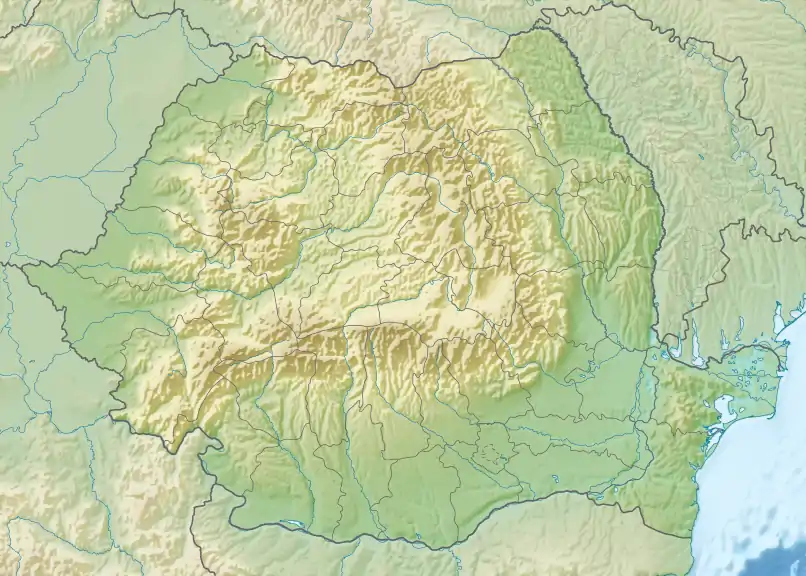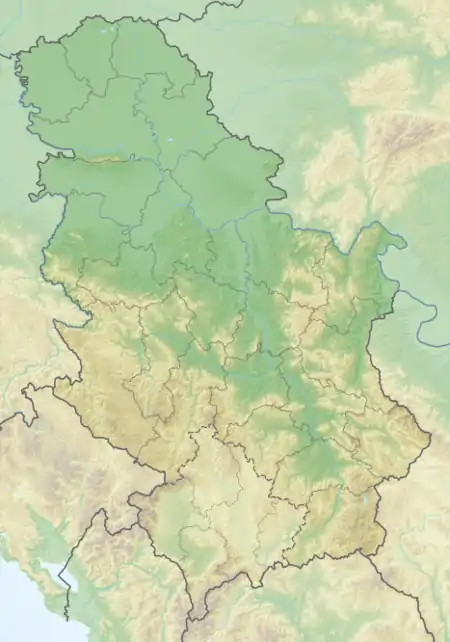Iron Gate II Hydroelectric Power Station
The Iron Gate II (Romanian: Porțile de Fier II, Serbian: Ђердап II, romanized: Đerdap II) is a large dam on the Danube River, between Romania and Serbia.
| Iron Gate II Hydroelectric Power Station | |
|---|---|
 | |
 Location of Iron Gate II Hydroelectric Power Station in Romania  Iron Gate II Hydroelectric Power Station (Serbia) | |
| Location | Gogoșu, Mehedinți County, Romania Mihajlovac, Bor District, Serbia |
| Coordinates | 44°18′16″N 22°33′54″E |
| Construction began | 1977 |
| Opening date | 1984 |
| Dam and spillways | |
| Impounds | Danube River |
| Height | 35 m (115 ft) |
| Length | 412 m (1,352 ft)[1] |
| Reservoir | |
| Creates | Iron Gates II Reservoir |
| Total capacity | 0.6 km3 (0.14 cu mi) |
| Catchment area | 579,200 km2 (223,600 sq mi) |
| Surface area | 52 km2 (20 sq mi) |
| Power Station | |
| Turbines | Romania: 10 × 32 MW Serbia: 10 × 27 MW |
| Installed capacity | Romania: 321 MW Serbia: 270 MW |
| Annual generation | Romania: 1.3 TWh Serbia: 1.31 TWh |
Characteristics
The dam is built at the Danube's 853 km (530 mi).[2] The project started in 1977 as a joint-venture between the governments of Romania and Yugoslavia for the construction of large dam on the Danube River which would serve both countries. At the time of completion in 1984 the dam had 16 units generating a total of 432 MW, divided equally between the two countries at 216 MW each.
The Romanian part of the power station was modernised and another 2 units were installed; the nominal capacity of the 10 units was increased from 27 MW to 32 MW thus having an installed capacity of 321 MW. The Romanian side of the power station produces approximately 1.3 TWh per annum.
The Serbian part of the power station currently has 10 units with a nominal capacity of 27 MW each and a total power generation capacity of 270 MW.[3] producing approximately 1.31 TWh per annum. At the celebration ceremony for the 27 years since the power station's deployment it was announced that production in 2011 reached 1.46 TWh despite bad weather conditions.[4] As of 2018 the Serbian side of the power plant is in the process of revitalization; when finished, the power of each aggregate will be lifted from 27 to 32 MW.[2]
Current total power generation capacity of the power station is 591 MW.
In 2011, a border checkpoint between Serbia and Romania for cars and light cargo vehicles was open.
Iron Gate III Hydroelectric Power Station
Plans for the third dam were drafted in 1973 by the Energoprojekt holding and Jaroslav Černi Institute. Selected location was the village of Dobra, in the Golubac municipality, at the Danube's 1,007 kilometres (626 mi). Iron Gate III was planned as the reversible power plant, which would pump water into the uphill reservoirs on the Brodica, Pesača and Železnički Potok localities. The tunnels were to lift water from the altitude of 68 metres (223 ft) (Danube level), to 407 metres (1,335 ft) (uphill reservoirs). The reservoirs would also accept water from the neighboring streams, and collect a total of 587,000,000 cubic metres (2.07×1010 cu ft) of water. All reservoirs would be connected with tunnels, from 1.95 kilometres (1.21 mi) (Pesača-Vodostan) to 8.1 kilometres (5.0 mi) long (Brodica-Pesača). In total, after three phases of construction, the power plant would have a total installed capacity of 2,400 MW.[5]
The studies were conducted into the 1980s, and the terrain was surveyed and measured, as it is made of karst. Apart from Yugoslavia and Romania, representatives of the electric companies from USSR and West Germany also participated in the surveys. Romania was to build a similar facility on its side of the river. Both states also planned additional power plants of 120 MW adjoining the third dams, which were to function only during the high water levels, accepting the water surplus. Besides the Iron Gate III dam, Yugoslavia also planned additional reversible power plant "Bistrica" (680 MW), built in the hills above the existing Bistrica power station on the Lim river. If built at the time, the Iron Gate III and Bistrica plants would make 37% of Serbian electricity production capacity in 2021.[5]
In August 2021, the construction was tentatively announced for 2022, having a major role in Serbian transition to renewable energy sources, though the price was set to "several billion euros". Other projects were also announced, which experts consider more feasible due to the Iron Gate 3's high price and complex system. Also, with other projects being finished first, the Iron Gate 3 would exceed Serbian needs in electricity, so they proposed that project should be a regional and interstate one. The complex will be completed in three phases, and when finished, it will produce 484 GWh of electricity per year.[6] In September 2021, U.S. company Bechtel expressed interest in building the dam,[7] and the meeting between Bechtel's president Stu Jones, Serbian energy minister Zorana Mihajlović, and US ambassador to Serbia Christopher R. Hill was held on 1 August 2022.[8][9]
By the end of the year, Serbian government allocated €1.5 billion in the 2022 budget for the construction of Iron Gate 3, or half of the total projected costs. The government also stated that a foreign, strategic partner will be needed. It is expected to be either some Chinese company (as they build numerous large infrastructure objects already), or a Russian one, as the Russians are already revitalizing the Iron Gate I dam. The construction is estimated to last for three to five years, in, now expanded four phases (I - 600 MW/2 billion KWh; II - 1.200 MW/3.1 billion MWh; III - 1.800 MW/5.2 billion KWh). After the final, phase IV, total capacity will reach 2.400 MW and annual production is estimated to 7.6 billion KWh. The power plant would be operational only at night.[10]
See also
References
- Specifications
- Slobodan T. Petrović (14 March 2018). ""Đerdap 2" najbliža veza sa Rumunijom" ["Đerdap 2" closest link to Romania]. Politika (in Serbian). p. 25.
- HE Đerdap 2 Technical Features (in Serbian) Archived 2012-03-06 at the Wayback Machine
- Municipality of Negotin: Iron Gate 2 Day
- Slobodan T. Petrović (30 September 2021). "Budućnost EPS-a je u "Đerdapu 3"" [Future of EPS is in "Đerdap 3"]. Politika (in Serbian). p. 14.
- Vladimir Spasić (23 August 2021). "Serbia to construct pumped storage hydropower plants Đerdap 3 and Bistrica". Balkan Green Energy News.
- eKapija (30 September 2021). "Bechtel Interested in Investing Billions in Green Energy – Djerdap 3 and Large Wind Farm Projects Worth EUR 2 Billion". eKapija.
- Михајловићева, Хил и "Бехтел" о "Ђердапу три" [Mihajlović, Hill and "Bechtel" talked "Đerdap III"]. Politika (in Serbian). 2 August 2022. p. 10.
- "Mihajlović, Hil i "Behtel" o energetici i Đerdapu 3" [Mihajlović, Hill and "Bechtel" talked energy and Đerdap 3]. Radio Television Vojvodina (in Serbian). 1 August 2022.
- Danas (7 December 2021). "Za izgradnju RHE Đerdap 3 potrebno još novca i strateški partner" [For the construction of pumped hydro power plant Iron Gate 3 more money and strategic partner needed]. eKapija (in Serbian).
External links
- Description Archived 2012-02-07 at the Wayback Machine (in Romanian)
- The history of Iron Gate II (in Romanian)